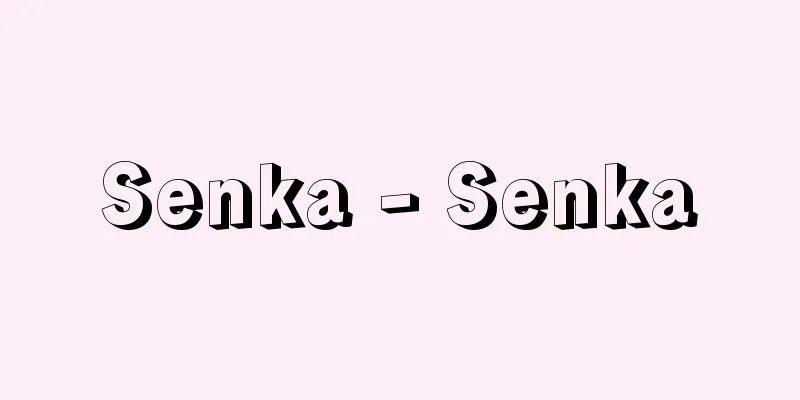Light theatre - Keiengeki

|
A genre of popular theater. It is a new type of comedy that became popular in the early Showa period, and the first was Casino Folly, which was launched in Asakusa, Tokyo in 1929 (Showa 4). Until then, Osaka comedy, represented by Soganoya Theater, dominated Japanese comedy, but this was completely different from the old morality and tradition of Osaka comedy. It was a modern comedy that incorporated jazz, revue, vaudeville, and slapstick gags from American comedy films, which were popular at the time, and developed mainly in Asakusa against the backdrop of the urban atmosphere of the time, creating a new trend. The term "light theater" was created around 1932 (Showa 7) as an analogy to the words heavy industry and light industry, which were widely used at the time, but this does not refer to the small scale of the theater, but rather to the method used, that is, nonsense comedy based on slapstick gags. Before that, it was called revue comedy or simply revue. From the Casino Folly, Enomoto Kenichi (Enoken) was marketed as a comedian, and in 1957, he was recruited by Shochiku and performed at the Asakusa Shochikuza Theater, where he gained popularity by performing many comedic revues of classic Kabuki plays and other masterpieces. In 1958, the "Kingdom of Laughter" was launched at the Tokiwaza Theater in Asakusa, and the two theaters competed for supremacy, while the "Moulin Rouge" was born in Shinjuku in 1956, creating an epoch, and many similar theater companies were born all over the country. Stars such as Shimizu Kinichi (Shimikin), Kido Shintaro (Kidoshin), and Morikawa Shin appeared, and some of the works had an avant-garde color. However, as the war situation intensified, this type of comedy was suppressed for being insensitive, as it made fun of the social situation and featured ad-libbed lines that were not in the censored script, and although it regained some momentum after the war, it rapidly declined from around 1950 (Showa 25) as it was overtaken by strip shows, and the term "light theatre" became obsolete. However, the techniques are still passed down to this day on television and in large and small theaters. [Soya Mukai] [References] | | |Source: Shogakukan Encyclopedia Nipponica About Encyclopedia Nipponica Information | Legend |
|
大衆演劇の一ジャンル。昭和初期から流行した新しい趣向の喜劇で、1929年(昭和4)東京・浅草に旗揚げされた「カジノ・フオーリー」がその最初である。それまでの日本の喜劇といえば曽我廼家(そがのや)劇に代表される大阪喜劇が主流を占めていたが、これら旧道徳性、因襲性に彩られていたものとはまったく異なり、当時流行のジャズ、レビュー、ボードビル、アメリカ喜劇映画のドタバタギャグなどを取り入れたモダンな喜劇で、当時の都会的風潮を背景として浅草を中心に発展、新しい流れをつくった。「軽演劇」の語は、1932年(昭和7)ごろ、当時盛んに使われた重工業・軽工業ということばに例えてつくられた用語であるが、これは規模の小ささを表すものではなく、その手法、すなわちスラプスティックなギャグを骨子としたナンセンス喜劇をさしたもので、それ以前はレビュー式喜劇とか単にレビューとかいわれていた。 カジノ・フオーリーからは榎本(えのもと)健一(エノケン)がコメディアンとして売り出し、32年に松竹へ引き抜かれて浅草松竹座へ出演、歌舞伎(かぶき)などの名作古典をレビュー化した喜劇を数多く上演して人気を集めた。33年には浅草の常盤(ときわ)座に「笑(わらい)の王国」が旗揚げされ、互いに覇を競い、また新宿には「ムーラン・ルージュ」が31年に誕生し、一つのエポックを築いたほか、各地に多くの同類劇団が生まれた。清水金一(シミキン)、木戸新太郎(キドシン)、森川信などのスターが輩出し、またなかには前衛的な色彩の作品もあった。しかし戦時色が強まるにつれ、この種の喜劇は世相をちゃかしたり、検閲台本にない台詞(せりふ)をアドリブでしゃべったり、とかく不謹慎との理由で弾圧を受け、戦後一時息を吹き返したものの、ストリップショーなどに押されて1950年(昭和25)ごろから急速に衰退し、軽演劇ということばも死語と化した。しかしその手法は現在もテレビや大小劇場に伝承されている。 [向井爽也] [参照項目] | | |出典 小学館 日本大百科全書(ニッポニカ)日本大百科全書(ニッポニカ)について 情報 | 凡例 |
Recommend
Inomata Party - Inomata Party
...There is no consensus on how to count the seve...
Kawanobe Iccho - Kawanobe Iccho
Year of death: September 5, 1910 (Meiji 43) Year o...
Oyna
...However, yukar originally referred to the &quo...
Betsugu - Second Shrine
A title given to the main shrine, referring to sh...
Mizuki
A district in the west of Dazaifu City, central Fu...
Copper-containing silumin - Gandou silumin
…(d) Al-Si-Mg alloys (AC4A, AC4C) are made by add...
Alcaçovas Agreement - Alcaçovas Agreement
…A treaty concluded in June 1494 between the Cath...
sheet flood
…It is also called head erosion or retreat erosio...
Taejo - Taiso
(1) Patriarchs In Catholicism, the term refers to ...
Most-favoured-nation treatment
In commercial treaties and agreements, this means...
Baron of Rio Branco (English name) José Maria da Silva Paranhos, Jr., barão do Rio Branco
1845‐1912 Brazilian diplomat, politician, and hist...
Andrology
…There are various fields that deal with sexual i...
La Cumparsita (English spelling)
...This is the most widely known tango song. It i...
reciprocity law
…The reciprocity law is also known as the recipro...
Olivine (Olivine)
It is an important rock-forming mineral, a general...









